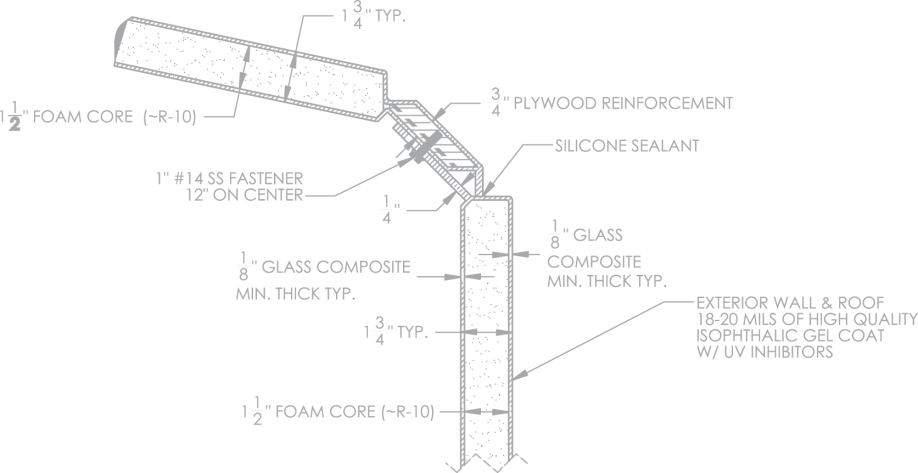High-Performance Composites for Eco-Friendly Building And Construction
High-Performance Composites for Eco-Friendly Building And Construction
Blog Article
Unlocking the Ecological Advantages of Recycled Composites in Building and Style
In the world of building and layout, the usage of recycled composites holds substantial pledge for enhancing sustainability practices and lowering ecological effect. The change towards a more sustainable future in these markets pivots on unlocking the complete potential of recycled composites.

Environmental Impact Reduction
The reduction of ecological effect through making use of recycled compounds in building and construction and design plays a vital role in sustainable techniques. By incorporating recycled compounds right into structure materials, the building industry can substantially decrease its carbon impact and add to a more green future. These lasting products, made from repurposed plastics, timber fibers, or various other recycled aspects, use a viable option to conventional building and construction materials without endangering on quality or durability.
Recycled composites help divert waste from land fills and reduce the demand for removing raw products, thus conserving all-natural sources. Furthermore, the manufacturing procedure of these compounds often consumes less energy and sends out fewer greenhouse gases contrasted to creating virgin materials (composites). This shift in the direction of utilizing recycled composites not only lessens environmental injury however likewise advertises a round economic situation by motivating the reuse of products that would otherwise be disposed of
Waste Reduction
With a concentrate on decreasing waste in building and construction and layout, the combination of recycled compounds provides a lasting option to decrease environmental effect. Waste minimization is a vital facet of sustainable practices, and using recycled compounds offers a chance to attain this goal efficiently. By making use of products that have currently offered their preliminary objective, such as recycled plastics or recovered wood fibers, the building and layout markets can considerably reduce the amount of waste created and sent to land fills.
Recycled compounds have the possible to draw away considerable quantities of waste from typical disposal methods, contributing to a more round economy where sources are utilized efficiently. Additionally, the manufacturing procedure of recycled composites frequently consumes less power and generates less emissions compared to virgin products, additionally decreasing the ecological footprint of building and construction and design jobs.
Implementing waste reduction approaches via the unification of recycled compounds not only helps in preserving all-natural resources but also advertises a more sustainable approach to structure and making for a greener future.
Power Conservation
Including recycled composites not only minimizes waste in building and construction and style but also plays a crucial role in improving energy conservation techniques within the market. The usage of recycled composites in building and construction can substantially contribute to energy preservation through various ways. The production of virgin products commonly calls for significant power inputs, whereas making use of recycled composites takes in much less energy, thus lowering overall power consumption. In addition, integrating recycled composites can contribute to better insulation homes in structures, minimizing the requirement for extreme home heating or air conditioning, and consequently decreasing energy usage for climate control. The light-weight nature of several recycled composites can lead to lighter structures, calling for much less energy for transport and installation. By advertising using recycled composites in go to this site construction and style, the sector can make substantial strides towards attaining energy performance and minimizing its carbon footprint, inevitably adding to a more lasting built atmosphere.
Carbon Footprint Reduction
Enhancing sustainability practices through the usage of recycled composites in building and construction and layout significantly lowers the carbon impact of the sector. By incorporating recycled materials into the manufacturing of composites, the demand for virgin sources reduces, resulting in reduced power consumption and greenhouse gas discharges related to standard manufacturing procedures. This reduction in carbon footprint is essential in combating climate change and advertising a more ecologically pleasant method to construction and design.
Moreover, using recycled composites likewise aids in drawing away waste from landfills, thereby alleviating the ecological see here now impact of disposal and advertising a round economic climate. The carbon footprint reduction achieved through the fostering of recycled compounds aligns with the international press towards sustainable techniques and the reduction of commercial emissions. It showcases a dedication to liable resource administration and a change towards greener choices in the building and construction and design industries. Inevitably, by focusing on the assimilation of recycled composites, the sector can make considerable strides in lowering its carbon impact and adding to a more lasting future.
Lasting Future
The assimilation of recycled compounds in construction and layout not just addresses instant environmental concerns but likewise lays a solid structure for a sustainable future in the industry. By integrating recycled compounds right into building materials and products, the building and construction and design sectors can significantly decrease their dependence on virgin sources, leading to an extra round economic climate. This shift towards sustainability is essential for reducing the ecological influence of standard building and construction practices, which commonly result in high degrees of waste generation and source depletion.

Final Thought
In verdict, recycled composites use significant ecological benefits in building and construction and layout by decreasing ecological effect, lessening waste, conserving energy, lowering carbon footprint, and promoting a lasting future. Embracing making use of recycled composites can add to an extra environmentally-friendly technique to structure and style, eventually resulting in a more anonymous sustainable and greener future for all.
The decrease of environmental impact via the use of recycled composites in construction and design plays a critical duty in sustainable methods.With a focus on reducing waste in construction and design, the integration of recycled compounds uses a sustainable option to minimize environmental impact. By promoting the use of recycled composites in building and design, the industry can make considerable strides in the direction of achieving power efficiency and reducing its carbon impact, eventually adding to a more lasting built atmosphere.

Report this page